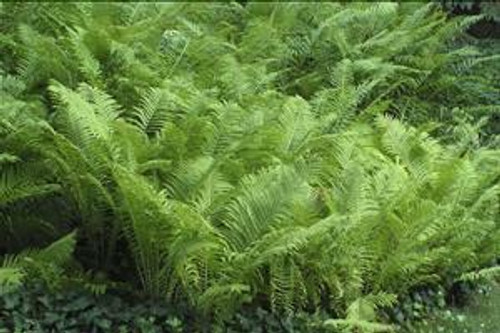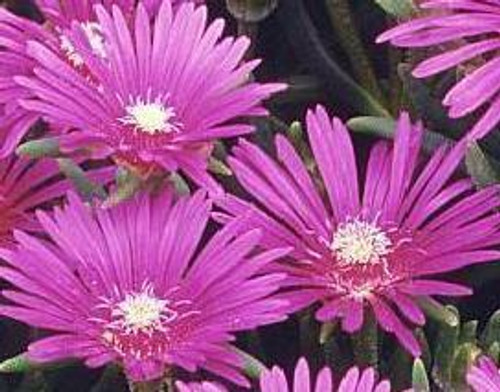Product Description
Matteuccia struthiopteris (3.5-inch pot)
Ostrich Fern or shuttlecock fern
One of the largest and most popular ferns in cultivation today. The dark green, pinnate fronds are shaped like ostrich plumes, being much wider at the top and tapering down to a bare stipe.
The first set of leaves is sterile and has a gracefully arching form. These leaves can reach heights of 6' in ideal environments. This set of leaves dies back by early to midsummer and is replaced by a set of fertile, dark green leaves which are about half the height of the sterile ones. These leaves turn a shiny bronze-gold in fall, becoming brown in winter.
Ostrich ferns need plenty of space to grow since they are rapid spreaders. They spread by dense underground runners which extend out in all directions, quickly forming colonies.
Native to marshy areas and creekbeds, Ostrich ferns prefer to be grown in moist, humus-rich soil with a neutral pH. If planted in cool, moist locations, they will tolerate full sun. In general, however, they prefer open shade.
Royal Horticultural Society's Award of Garden Merit -- 1993
Height: 3.0-6.0 Feet
Spread: 3.0-4.0 Feet
Hardiness Zones: 3,4,5,6,7
Foliage Color: Green shades
Sunlight: Full Sun (> 6 hrs. Direct Sun) - Full Shade (< 4 hrs. Direct Sun)
Average to Consistent Water Needs
Average to Fertile Soil Quality
Deer and Rabbit Resistant
Growth Rate: Rapid
Bog Plant, Border Plant, Cut Foliage, Ground Cover, Attractive Foliage, Native to North America
Bring the Graceful Beauty of the Ostrich Fern to Your Shade Garden!
Matteuccia struthiopteris, commonly known as the Ostrich Fern, is a majestic and elegant fern prized for its tall, vase-shaped fronds that resemble ostrich plumes. This deciduous fern thrives in moist, shady environments, making it a perfect choice for woodland gardens, shaded borders, or naturalizing in damp areas.
The Ostrich Fern is a native fern known for its impressive size and graceful appearance. Its fronds emerge in spring, forming a stunning vase-like shape with feathery, arching fronds that can reach up to 5 feet tall. The bright green fronds create a lush, tropical feel in the shade garden. In the fall, the fronds turn a beautiful golden yellow before dying back for the winter. This fern spreads through underground rhizomes, eventually forming large colonies, making it an excellent choice for naturalizing in moist, shady areas.
- Mature Size: 3-5 feet tall, spreading indefinitely
- Frond Color: Bright green in spring and summer, turning golden yellow in fall
- Growth Habit: Upright, vase-shaped, spreading by rhizomes
- Light Needs: Partial to full shade
- Soil Needs: Moist, fertile, well-drained soil
- Hardiness Zones: 3-7 (USDA)
- Special Features: Deciduous, graceful fronds, naturalizes well, low maintenance
Planting:
- Timing: Plant in spring or fall for best results.
- Location: Choose a shady or partially shaded location with moist, fertile soil. Ostrich Ferns thrive in damp areas, making them ideal for woodland gardens, stream banks, or areas with consistent moisture.
- Soil Preparation: Amend the soil with plenty of organic matter, such as compost or well-rotted manure, to improve drainage and moisture retention.
- Spacing: Space plants 3-4 feet apart to allow for their spreading growth habit.
- Planting Depth: Plant the crown (where the fronds emerge) at the same level as the soil surface.
- Watering: Water thoroughly after planting and regularly until it is established.
Care:
- Watering: Ostrich Ferns require consistently moist soil. Water regularly, especially during dry spells. Avoid letting the soil dry out completely.
- Fertilizing: Apply a balanced fertilizer in spring as new growth begins. Avoid over-fertilizing.
- Mulching: Apply a layer of mulch around the plants to retain moisture, suppress weeds, and protect the shallow roots.
- Pruning: Remove any dead or damaged fronds in late winter or early spring before new growth emerges.
- Pest and Disease Control: Ostrich Ferns are generally pest and disease resistant.
Uses in the Garden:
- Woodland Gardens: A perfect choice for woodland gardens, adding a touch of elegance and lushness to the understory.
- Shade Gardens: Thrives in shady gardens or areas under trees.
- Naturalizing: Excellent for naturalizing in damp, shady areas, creating a lush, fern-filled landscape.
- Borders and Edging: Adds a dramatic vertical element to borders and edges.
- Mass Plantings: Plant in groups for a stunning display of foliage and texture.
- Erosion Control: The spreading rhizomes can help stabilize slopes and prevent erosion.
Bring the graceful beauty of the Ostrich Fern to your shade garden and enjoy its lush, feathery fronds!
Other Details
The most important part of the plant is its root system. Healthy roots are the foundation of a healthy, vibrant plant. The type of plug container used is based on the specific needs of the plants. Perennials offered as bare root traditionally perform better when planted as bare root.Planted in a specialized mix, potted plants have well established root systems. Top growth stage will vary depending on the current life cycle and time of year when shipped. In Winter and early Spring dormant plants may be shipped. Dormant plants may be planted right away, even before the last frost date.
Most bare root varieties are field grown for at least one season, though Hemerocallis and Hosta are grown for two seasons. The bulk of the soil is removed during the harvesting process and the tops of most varieties are trimmed back to the crown. They are graded, packed in shredded aspen or sphagnum moss and stored in freezers until ready to be shipped.
See our Container Sizes and Bare Root Perennials pages for more information.
Plant information and care is provided in the Overview section, Plant Genus Page and general information is provided in the Planting Care & Guides. Additional questions can be asked on each Plant page.
Plant Spacing: Using the maximum mature spread or width of a plant to guide spacing, ensures space to grow to full size. To fill an area sooner, plant them closer together. Just remember, future thinning or transplanting may be needed.
Water: Keep a close eye on newly planted perennials, especially throughout the first growing year. Most early plant loss is due to too much or too little water!
Product Videos
Custom Field
Product Reviews
2 Reviews Hide Reviews Show Reviews
-
Plants came as advertised
Plants came healthy and well packaged. I will definitely buy from them again.
-
Very pleased!
Though a little less mature than I expected, I was nonetheless impressed with the state of the ferns when I received them. I dreaded that there would be damage to the fronds, but ALL of the plants were just fine, and very, very healthy! I'm trying to naturalize a rather ugly front wooded area...and desperately trying o squeeze out a lot of Asian Stilt Grass that has tried to take over, and this particular fern will help me. I will be ordering more for sure! Good job!


























